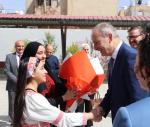You are here
The moral imperative of refugee education
Feb 15,2023 - Last updated at Feb 15,2023
ENEVA — Talent might be universal, but opportunity is not. Throughout my life, I have met numerous schoolchildren and university students who were enjoying their studies, acquiring knowledge and skills, making lifelong friends, and working toward their future before a dramatic, life-changing event took it all away. Suddenly, they were in danger and forced to flee their homes. Their talent remained undiminished, along with their enthusiasm and desire, but the opportunity disappeared, sometimes for good.
In addition to jeopardising young people’s physical and mental well-being, forced displacement has a devastating effect on their education, imperiling their future health, employment prospects and incomes. If every adult in the world completed primary and secondary education, according to UNESCO, the global poverty rate would be more than halved. A World Bank study found that each additional school year can increase a girl’s future earning power by 12 per cent. Moreover, adults with a college education and above have been shown to live healthier and longer lives, marry later, and be less likely to experience early pregnancy.
But there is more. Beyond creating opportunities for career advancement, education can provide a safe environment, particularly for displaced children. For young people uprooted from their homes, playgrounds, sports teams and friend groups, school offers a protected space, a measure of stability and normality, and the chance to form new connections, enabling children and adolescents to explore and investigate while giving them the tools to thrive in the adult world.
Given the benefits that education can bring, it is unacceptable that nearly half the world’s school-age refugee children are currently not in school. According to the UN Refugee Agency (UNHCR), which I lead, refugee children’s gross enrollment rate at the primary level stood at 68 per cent during the 2021-22 school year, compared to roughly 100 per cent enrollment for their non-refugee peers. At the secondary level, the gross enrollment rate for refugees was significantly lower, at 37 per cent, which was below the average for non-refugees in every region.
Encouragingly, refugee enrollment at the tertiary level has increased from 1 per cent to 6 per cent over the past few years, reflecting the UNHCR’s efforts to increase young refugees’ enrollment in higher education by 2030.
But there is still much work to be done. Of the 26.7 million refugees currently under the UNHCR’s mandate, three-quarters live in low- and middle-income countries, and more than 20 per cent reside in the world’s least-developed countries. While many refugee-hosting countries have enacted inclusive refugee policies, they lack the resources, such as extra teachers and facilities, to provide quality education. And even when resources are available, many refugee families, like all economically vulnerable people, must weigh the cost of books, transport, and fees against other necessities like health care and electricity.
Investing in education means investing in development, human rights, and peace, particularly when it comes to refugees who could rebuild their countries of origin when they are able to return. But to ensure that they are educated by qualified teachers and have access to up-to-date learning materials, young refugees must be integrated into their host countries’ education systems.
Accomplishing this would require a massive collective effort, which is why the international community must support host countries, many of which have relaxed immigration controls to allow for the integration of refugees. In January 2021, a joint UNHCR-World Bank report estimated the annual cost of educating all refugee students in low-, lower-middle, and upper-middle-income host countries, from the first grade to the last year of high school, at $4.9 billion. But this was well before Russia’s invasion of Ukraine displaced millions more pupils.
This figure may seem intimidating to many. But it is a fraction of the average annual education expenditures in refugee-hosting countries and minuscule compared to high-income countries’ education spending. Moreover, when weighed against education’s positive impact on employment and skills, health outcomes, poverty alleviation and economic inclusiveness, not to mention intellectual fulfillment and human dignity, $4.9 billion per year is an extremely modest outlay.
Moreover, spending wisely can yield outsize returns. The World Bank study also showed that by focusing on low- and lower-middle-income countries, which account for just 20 per cent of global education expenditures, we could ensure that nearly half of all school-age refugees complete their education.
At the UNHCR’s first Global Refugee Forum in 2019, hundreds of companies, foundations, universities and philanthropists committed to provide support for refugee education, from funding to policy and advocacy work. The second forum, which will be held in Geneva in December, offers an opportunity to scale up these commitments. Several countries, including Norway, Sweden, and Denmark, have already introduced or pledged to adopt more inclusive policies. But to capitalise on these measures and develop the necessary infrastructure, more investment is needed.
Providing all children in crisis with the educational opportunities they deserve is among the defining challenges of our time. Ensuring that children fleeing from conflict can still learn will contribute to a more peaceful, resilient world and help close the yawning gap between talent and opportunity. The cost of failure could be immense, but success would pay dividends for many years to come.
Filippo Grandi is United Nations high commissioner for refugees. Copyright: Project Syndicate, 2023. www.project-syndicate.org











